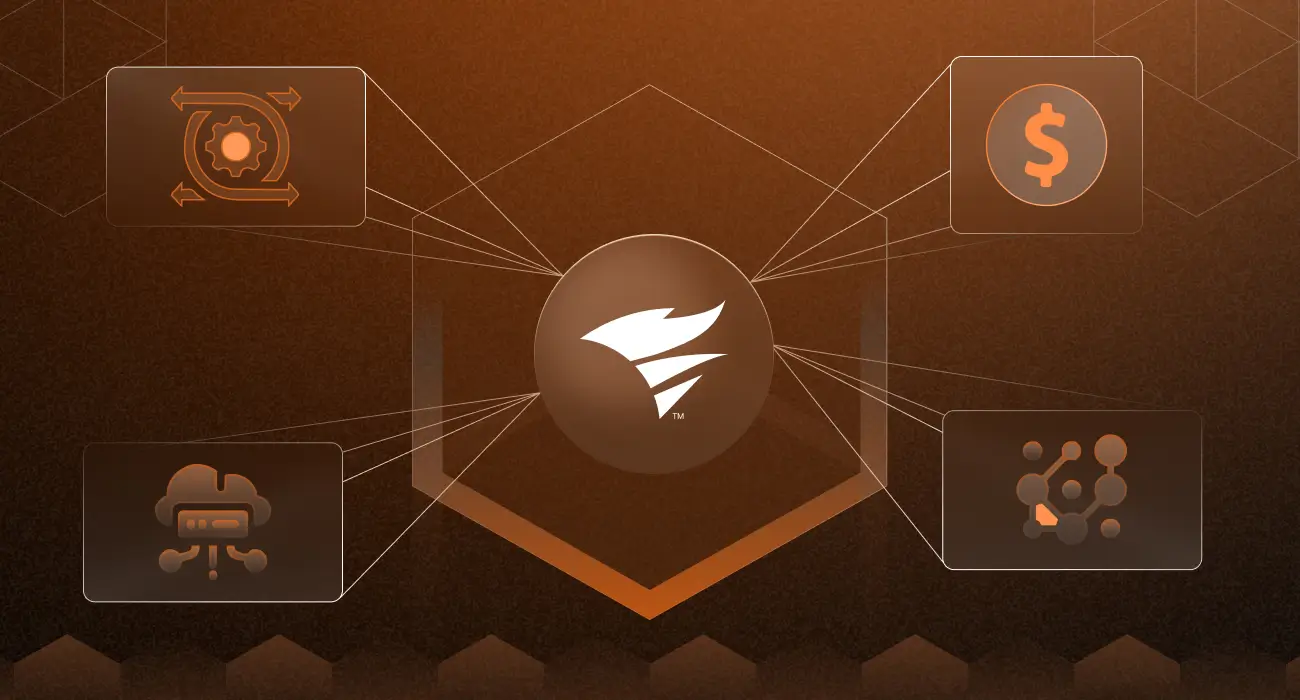SolarWinds is a widely used solution for monitoring IT infrastructure. It helps manage system health, monitor network traffic, and send alerts when problems arise. However, despite its popularity, many teams are now exploring SolarWinds alternatives. This is primarily due to high costs, complex setup requirements, and scalability limitations, which make it less suitable for some growing businesses.
While SolarWinds offers valuable features, such as real-time alerts, auto-discovery, reporting, and capacity planning, it may not be the ideal fit for every organization.
Why Go For SolarWinds Alternatives?
Although SolarWinds comes with an impressive list of features, it may not align with the needs of all DevOps teams and organizations. As a result, many begin searching for alternatives. Some of the most common reasons include:
1. Cost: The pricing can increase tremendously with the expansion of the company, which becomes quite unbearable for smaller businesses or start-ups.
2. Complex setup and learning curve: Setting up SolarWinds takes time and can be complicated for beginners. The complex dashboards and the number of features can easily overwhelm the users.
3. Not flexible: Businesses require tools that are easy to use, scalable, and flexible in dynamic environments. Sometimes SolarWinds can’t keep up.
4. Too many features: Businesses generally need the basic essential features only, like monitoring and alerts. So why pay extra for features that you are never going to use?
5. Resource-heavy: SolarWinds requires a large amount of system resources, which means that your low-spec or limited-resource systems may slow down or require high-end hardware to perform the duties with which it is tasked. This is not good for a program that needs to be lightweight and run on a budget in some environments.
6. Security concerns: Some organizations may have begun to shy away from using the SolarWinds product line due to fears about putting their environment at risk after the 2020 SolarWinds breach.
7. Slow with customer support and updates: Other users complain about slow support and updates, which can hinder productivity severely when something goes wrong.
Best Alternatives to SolarWinds
Many companies are actively searching for SolarWinds alternatives that are easy to use and affordable. Some of the top SolarWinds competitors are:
1. Middleware
Middleware is the latest monitoring tool designed for DevOps teams seeking something simple, quick, and inexpensive. As a powerful SolarWinds alternative, it stands out by not bombarding users with endless options to sift through.
Keeping it simple while providing clear details to help you monitor applications, servers, and logs to ensure everything is alive and kicking. Whether you’re running a website, a cloud app, or an internal business system, it helps you see everything in one single, clean, and easy-to-use dashboard.
Middleware is perfect for small teams and large companies. It’s flexible, lightweight, and sufficient to run the software without sacrificing your resources. The easy-to-use software goes a long way and does not require a manager or a tech-savvy user; it’s plain and simple, so it works well for startups as well as companies without IT managers.
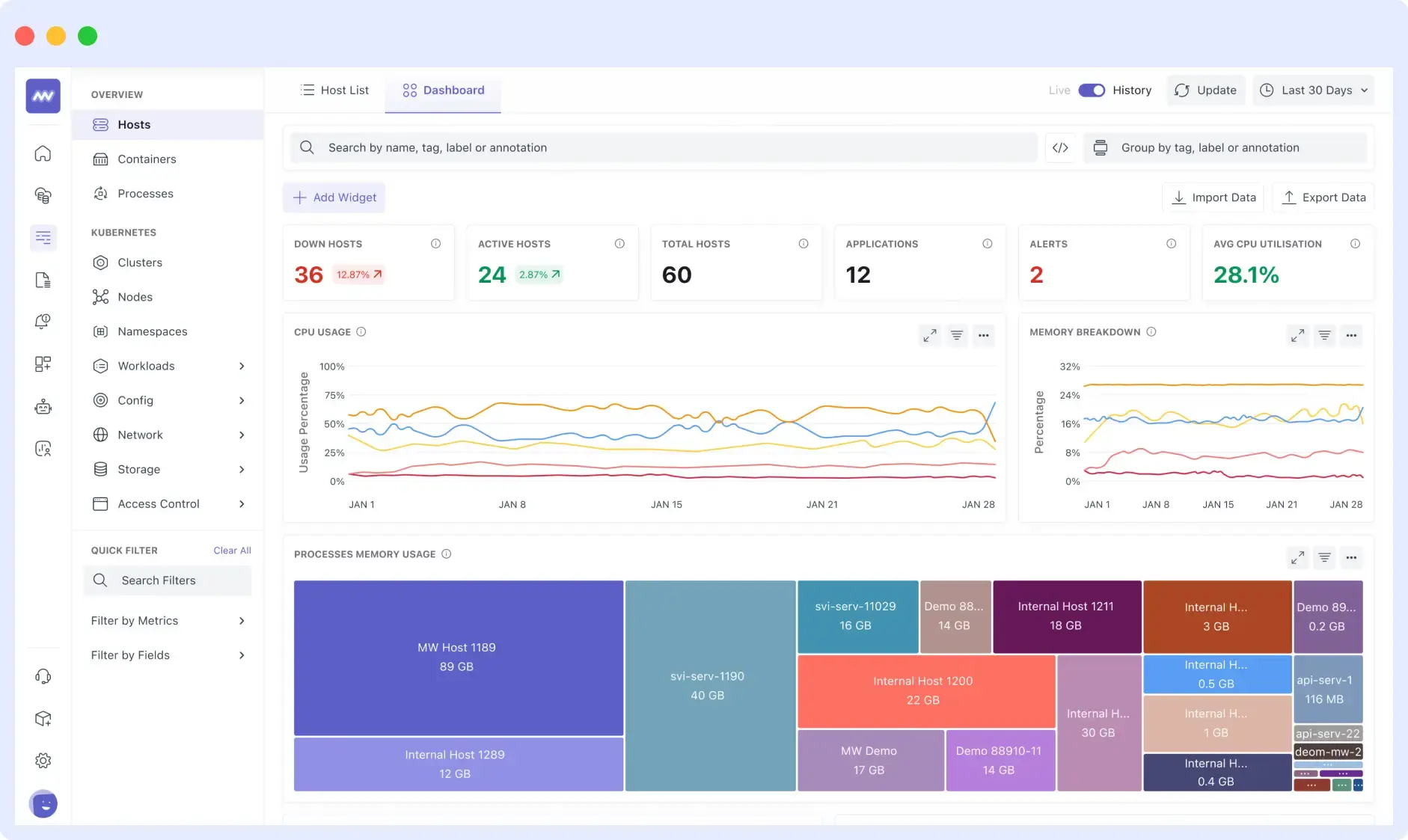
Key Features
- Full-Stack Monitoring: Track everything from applications and servers to containers and databases all in a single platform.
- Real-Time Alerts: Get instant alerts for any issues via Slack, MS Teams, or email, with customizable rules and thresholds.
- Advanced Log Monitoring: Aggregate, filter, and analyze logs from various sources with structured log support and real-time search.
- Application Performance Monitoring (APM): Trace requests end-to-end across your system, identify bottlenecks, and fix issues faster.
- Real User Monitoring (RUM): Understand how real users experience your website or app, including Core Web Vitals and frontend performance.
- Synthetic Monitoring: Run automated uptime checks and performance tests from global locations to ensure reliability.
- Pre-Built & Custom Dashboards: Create dashboards with metrics, logs, traces, and uptime in one place — no code required.
- Lightweight Agent: Easily install the agent with minimal system load, supporting Docker, Kubernetes, and direct installs.
- 200+ Third-Party Integrations: Instantly integrate with popular tools and platforms like AWS, Redis, PostgreSQL, Apache, Jenkins, and more.
- Ingestion Control: Set rules to manage how much data you collect and store, avoid cost surprises.
Pricing
- Free Forever: Includes up to 100GB data, 1,000 RUM sessions, 20,000 synthetic checks, unlimited users, community support, and 14-day data retention.
- Pay As You Go (starting at $0.30 per GB): Everything in Free, plus $1 per 1,000 RUM sessions, $1 per 5,000 synthetic checks, ingestion control, 30-day retention, SSO, and dedicated Slack/MS Teams support.
- Enterprise (Custom Pricing): Volume discounts, premium support, on-premise deployment, dedicated account team, custom data retention, multi-year contracts, and 24×7 support.
Why is Middleware a better alternative to SolarWinds?
Middleware is designed with speed and ease of use in mind. In contrast, SolarWinds feels cumbersome and unnecessary. it avoids extra features and focuses on the core things modern teams need: clear dashboards, speed of setup, and affordable pricing. It is simpler to get started with and does not require technical depth or skill, so it is much easier for focused teams and growing startups.
2. Datadog
Yet another tool that is used by various companies for real-time monitoring of cloud systems and applications is Datadog. It could come in handy for teams using cloud services such as AWS, Azure, or GCP.
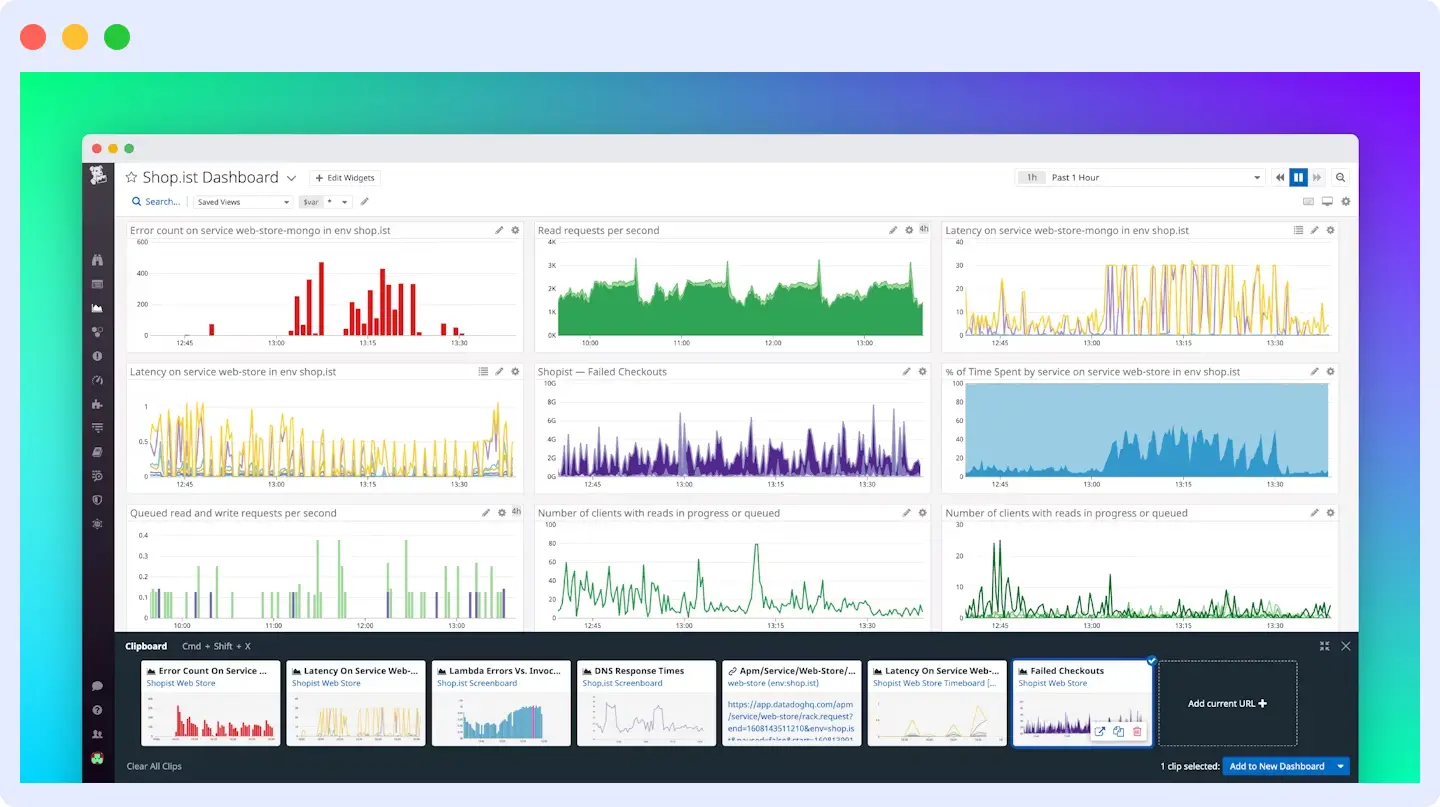
Key features
- Unified Monitoring: Datadog gives you the power to track everything from system health to app performance in one place.
- Log Management: It also lets you manage and view your logs, monitor cloud services, and get alerts when something breaks.
- Custom Dashboards: You can build custom dashboards that show exactly the data you care about.
- Extensive Integrations:: It supports more than 600 integrations, so it can be easily integrated with tools that your team is already using.
Pricing
- Free Plan: Free of charge, best for small setups (max. 5 systems).
- Pro Plan: From $15/month/system (annual billing), provides additional monitoring options.
- Enterprise Plan: From $23/month/system (annual billing), offers additional tools for larger teams.
- Cloud Security (Pro): From $22/month/system, provides cloud protection options.
Why Datadog is a better alternative for SolarWinds?
Regarding flexibility, Datadog blows SolarWinds away, user experience is also great. Datadog supports over 600 integrations, which work well with cloud platforms like AWS and Azure, making it ideal for modern cloud-based companies. Datadog makes monitoring doable with little setup effort if you are looking to centralize everything in one place.
3. Dynatrace
Dynatrace is a smart monitoring tool that uses AI to offer deep insights into how the system and apps are performing. It is mainly designed for large businesses and enterprises.
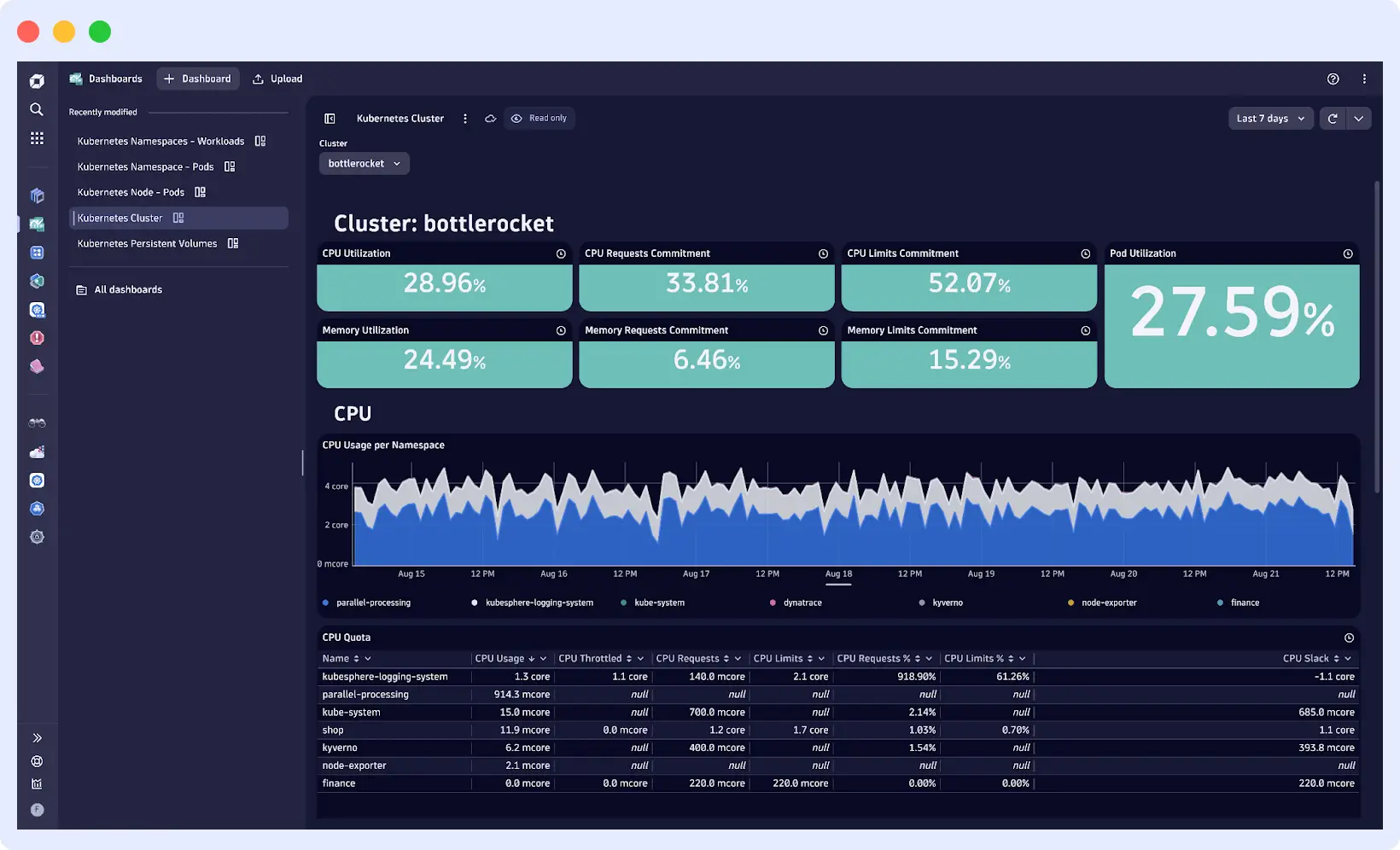
Key features
- Comprehensive Monitoring: Dynatrace watches your entire system, apps, servers, users, and cloud services and gives you one clear view.
- AI-Powered Issue Detection: It uses AI to find problems automatically, so your team doesn’t have to search for issues manually.
- Root Cause Analysis: It also helps you understand the root cause of slowdowns or errors very quickly.
- Multi-Platform Support: You can monitor multiple platforms, including mobile apps, cloud services, and backend servers.
- Feature-Rich Platform: It’s packed with features but might feel too complex for small teams or beginners.
Pricing
- Full-Stack Monitoring: $0.08 per hour. Keeps an eye on everything: apps, servers, networks, all in one.
- Infrastructure Monitoring: $0.04 per hour. Just check your servers and cloud setup.
- Kubernetes Monitoring: $0.002 per hour. Watches over your Kubernetes pods.
- Application Security: $0.018 per hour. Helps spot and protect against app threats.
- Real User Monitoring: $0.00225 per session. Tracks real users using your app or website.
- Synthetic Monitoring: $0.001 per test. Pretend users test your site to see if it’s working fine.
Why Dynatrace is a better alternative for SolarWinds?
Dynatrace is unique with its AI-powered insights, which give teams the ability to find and fix problems quickly, compared to SolarWinds. SolarWinds requires manual setup and rule-based alerts, while Dynatrace uses intelligent monitoring to automatically detect problems and is able to provide the root cause. It’s a solid fit for enterprises looking for visibility into their application while improving monitoring and wanting less time spent configuring systems.
4. New Relic
Another effective tool for full-stack observability is New Relic. It assists developers to keep track of the performance of their systems and apps in real time.
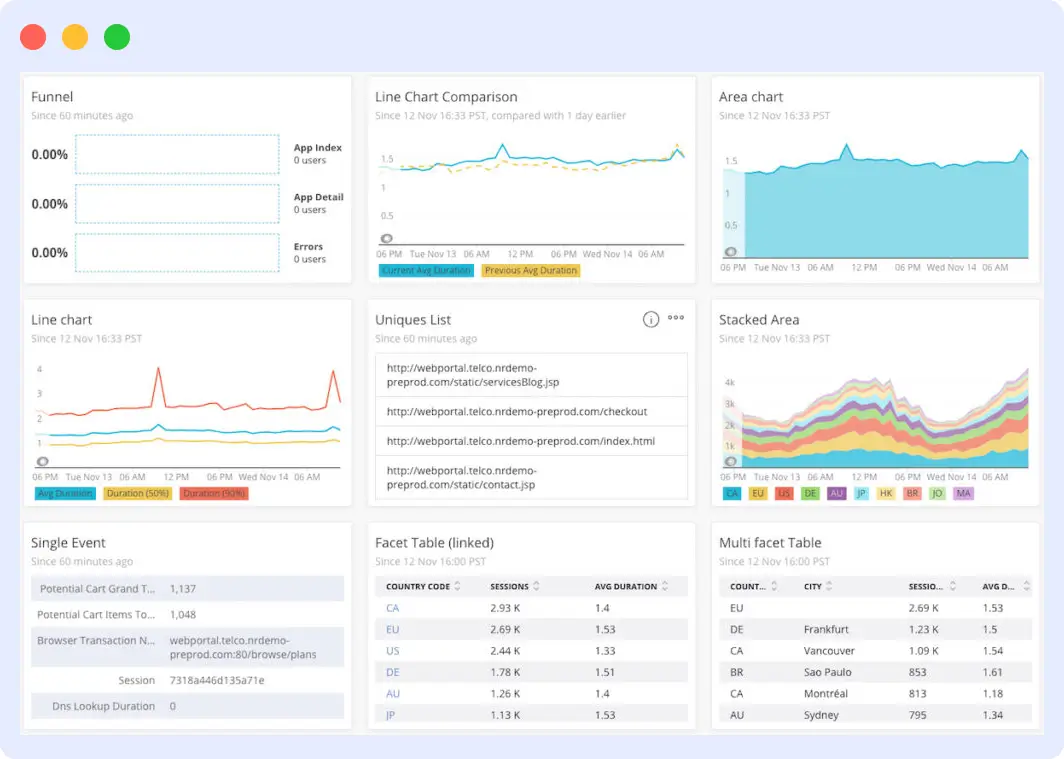
Key features
- Unified Data Collection: You can gather and examine data from all areas of your system, including logs, metrics, traces, and user interactions, with New Relic.
- Pre-Built Dashboards: There are included, saving you the trouble of starting from scratch.
- Early Issue Detection: Even in complex systems, it is effective at assisting you in identifying bugs and performance problems early on.
- Seamless Integrations: You can easily integrate it with your existing tools and platforms.
Pricing
- Free: $0. Great for trying it out. You get 100GB of data, 1 full user, and access to all core features.
- Standard: For small teams. Up to 5 users. Basic support. Good for starting out with monitoring.
- Pro: For growing teams. Unlimited users. Faster support. Pay based on what you use (no user fees if you choose).
- Enterprise: For large businesses. Top-level support. Security options like HIPAA. Priority service and faster help.
Why New Relic is a better alternative for SolarWinds?
New Relic is a full-stack observability tool that comes with a more modernized and user-friendly experience than SolarWinds. New Relic has real-time insights, customised dashboards, and very seamless integrations. SolarWinds can be limited due to its outdated interface and difficult navigation, but New Relic was built for developers who want just enough flexibility without the added complexity for the team.
5. Nagios
Nagios is one of the most reputable and oldest monitoring tools in the market. It is an open-source product and for ages has been used by IT teams that prefer control with customization.
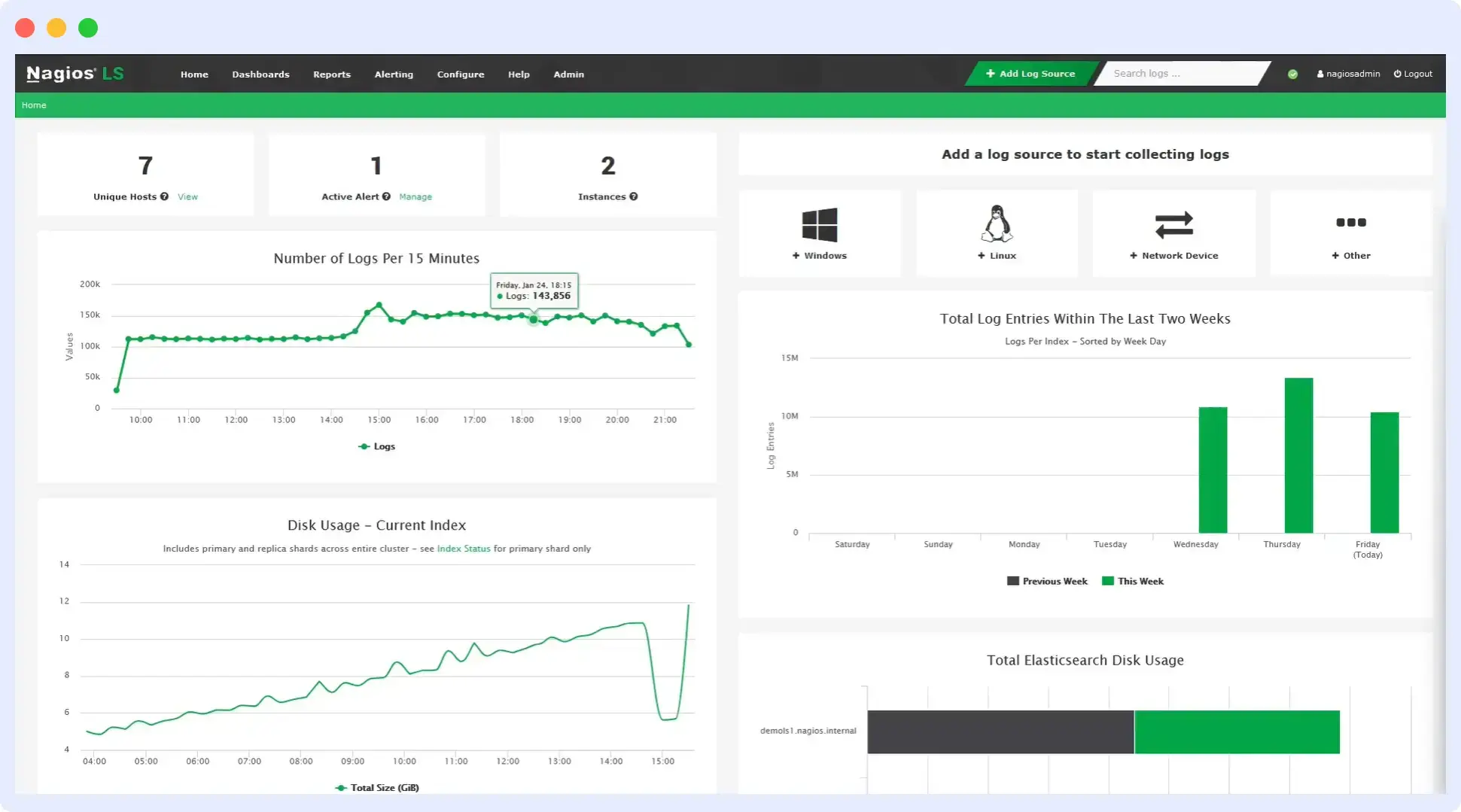
Key features
- Comprehensive Monitoring: Nagios is great for keeping an eye on networks, servers, and hardware like switches and routers.
- Customizable with Plugins: You can modify it to precisely suit your needs by adding custom plugins.
- Highly Adaptable: Flexible enough for complex environments, though it may require technical setup.
- Real-Time Alerts: To be informed when something goes wrong with your system, you can set alerts.
Pricing
- Free Version: Best for small environments – supports limited monitoring (up to 7 nodes).
- Standard Edition: Starts around $2,500 for 100 devices. Pricing scales with the number of monitored devices, going up to ~$24,000 for unlimited.
- Enterprise Edition: Starts around $4,500, offering advanced features like capacity planning and SLA reports. Scales up to ~$26,000 for unlimited monitoring.
- Sitewide License: Custom pricing for large organizations needing enterprise-level monitoring across multiple environments.
Why Nagios is a better SolarWinds alternative?
If a team wants the ability to control and customize their monitoring, Nagios is a much better option than SolarWinds, which does not allow for easy enhanced customization. Nagios, being an open-source tool, lets users create their own plugins and build exactly the system that they want. Instead of SolarWinds overhead, it usually ends up being cheaper if organizations have the technical skills and can support a self-hosted, highly configurable solution.
SolarWinds Alternatives Comparison
| Product | Key Features | Pricing Model | Notable Differentiators |
| Middleware | -Real-time infrastructure, application, and log monitoring -AI-powered insights -Datadog agent compatibility -Advanced alerting -Status pages with incident management -Real user monitoring (web & mobile) -Log pattern detection and historical analysis -Full access to all features with no restrictions | Free for a limited time; then pay-as-you-go based on actual usage (no traditional tiers, transparent costs) | 10x more cost-effective than competitors, transparent pricing, no feature gating, effortless scaling, developer-friendly, fast setup |
| Datadog | – Unified infrastructure, application, and log monitoring – 600+ integrations – Custom dashboards – Cloud-native support | Free (up to 5 hosts); Pro and Enterprise plans per host | Highly scalable, best for cloud environments |
| Dynatrace | – AI-powered full-stack observability – Automated root cause analysis – Multi-platform monitoring | Usage-based (per hour) | Advanced AI automation, deep analytics |
| New Relic | – Logs, metrics, traces, user monitoring – Pre-built dashboards – Seamless integrations | Free (100GB); Standard, Pro, Enterprise (user/data-based) | Modern UI, real-time insights, developer-centric |
| Nagios | – Network/ server/ hardware monitoring – Custom plugins – Alerting | Free (basic); Paid (per device) | Open-source, highly customizable, and cost-effective for skilled teams |
Why Middleware Is The Best SolarWinds Alternative?
Middleware stands out from other tools because it is simple to use, affordable for all kinds of teams, and gives you everything you need in one place.
- Zero Fluff, Maximum Focus: Most tools overwhelm with cluttered dashboards, but Middleware takes a clarity-first approach; showing only actionable, useful metrics, alerts, and logs to save your time.
- Developer First by Design: with minimal setup, GitOps-friendly features, and seamless CI/CD integration to help you move faster.
- No Lock-In, No Surprises: Middleware offers transparent pricing with no hidden fees or feature paywalls, scale at your pace without worrying about vendor lock-in or budget shocks.
- Built for Transparency and Collaboration: Middleware enables open observability, making it easy for teams to share dashboards and alerts; breaking silos and boosting collaboration.
- Open Ecosystem and Rapid Innovation: With an open plugin architecture and user-driven feedback, Middleware delivers fast updates based on real needs, no waiting years for upgrades.
- Privacy-First Observability: Middleware protects your privacy by not collecting your data or accessing your systems without permission. You decide what to monitor, store, and share.
If you’ve read this far, you’re ready to try a better SolarWinds alternative. Whether you want something easier or more affordable, Middleware stands out by offering simple, smart monitoring without the hassle. It’s great for small businesses, tech teams, and growing companies.
Try Middleware for free — no credit card, no vendor lock-in, just clean and powerful observability from day one.
Feel free to explore other options too, but starting with a free trial is the best way to find what fits your team.
FAQs
What is the best alternative to SolarWinds?
Middleware is the best alternative for SolarWinds. It offers all the required features like monitoring and dashboards, without complicated setups or high prices. It is fast, easy to use, and is suitable for small and large teams as well.
Is Datadog more effective than SolarWinds?
Datadog is mostly regarded as the giant competitor of SolarWinds in cloud-based companies. It has many powerful features and can provide very elaborate insights. But as your team grows, you might find Datadog to be a bit costlier. It is a good bet when you want more features along with customized controls, but it can become pretty heavy for smaller teams.
Are these free substitutes for SolarWinds?
Yes, a few good alternatives exist that are free. Middleware offers all the features for free in its free plan. Nagios Core is also free, but takes relatively longer to install and learn. If you need something with all the required features, easy to use, and free to use as well, Middleware is what you must opt for.
What are the main reasons to switch from SolarWinds?
The main reasons include enhanced security, better support for modern cloud-native environments, flexible and transparent pricing, improved ease of use, and faster innovation without vendor lock-in.
You may also be interested in:
- What Is Observability?
- Top 12 API Monitoring Tools to Try in 2025
- 14 Best Website Monitoring Tools of 2025 (Free & Paid)
